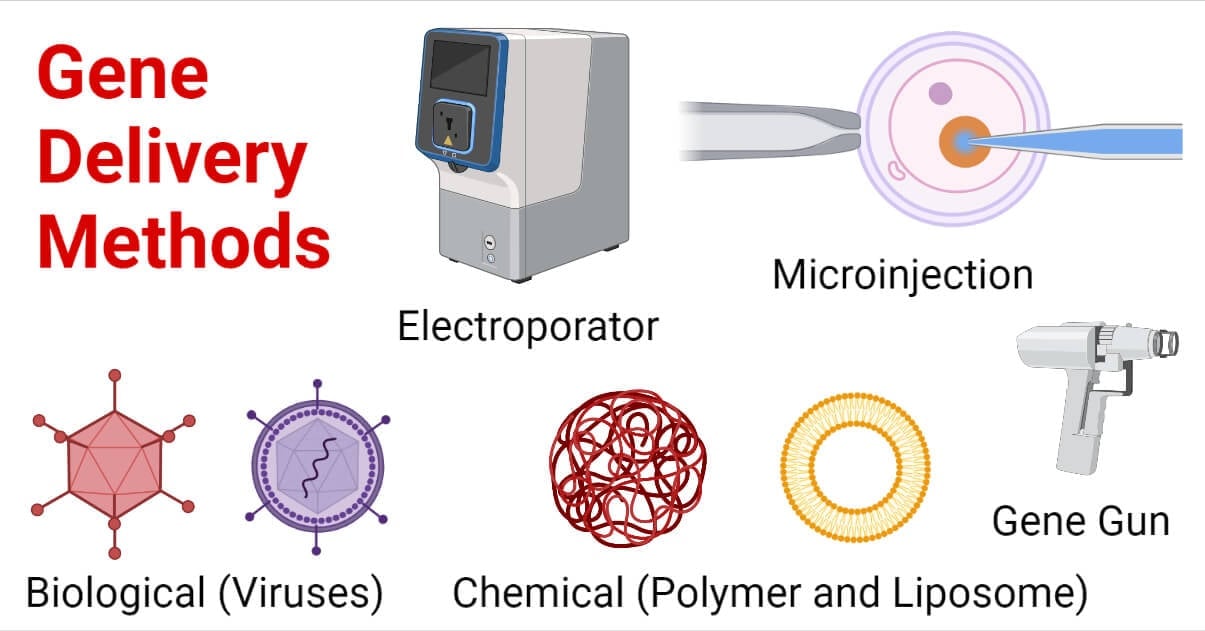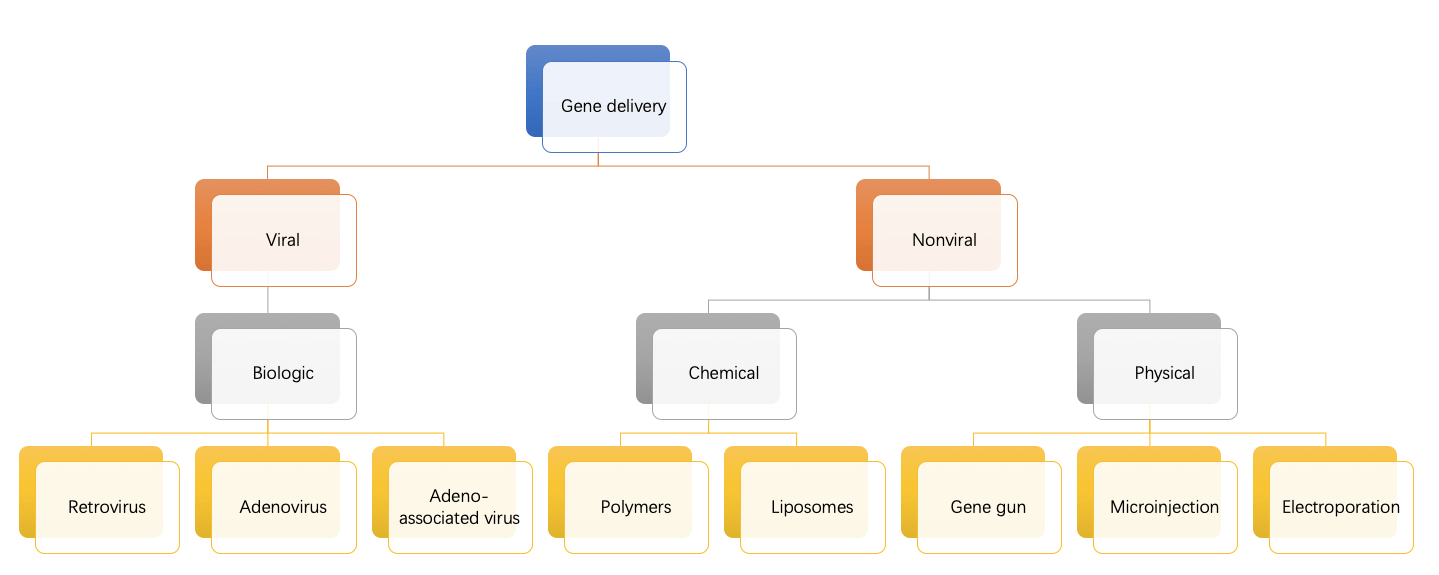
One of the biggest problems in somatic gene therapy is finding an efficient gene delivery system. Appropriate methods to deliver DNA used in gene therapy are vital, as the targeted tissues must properly receive the appropriate genes.
Gene therapy can be carried out using naked DNA delivered directly into the target cells. However, this can be introduced by isolated DNA molecules has a very low-efficiency rate. To increase the efficiency of DNA uptake by the target cells, special vectors have been engineered for gene transfer.

Interesting Science Videos
Types of Gene Delivery Methods
There are two basic gene delivery methods are:
- Nonviral transfection method
- Viral mediated transduction method
1. Nonviral transfection methods
There are currently 2 nonviral transfections (liposome and biolistic) that have been tested for in vivo or ex vivo gene therapy approaches
a. Liposomes mediated
The DNA to be transferred is packaged in vitro with liposomes and used directly for gene transfer to a target tissue in vivo. Liposomes can be cationic and anionic. Although, anionic liposomes are surrounded by a negative surface charge upon binding DNA on the inside. The lipid coating allows the DNA to survive in vivo, bind to cells, and be endocytosed into the cells.
Advantages: No viral components, no – pathogenic, no immunity problems, no limit to size of a foreign gene.
b. Biolistics
The process involves the acceleration of high-velocity DNA-coated microprojectiles into the cells. Potential advantages and disadvantages are as same as a liposome-mediated transfer.
2. virus-mediated transduction methods
Viruses attack their hosts to introduce their genetic material. This genetic material contains instructions to produce these viruses. The host cell will carry information to produce the viruses. In addition to the instructions producing the components of the virus itself, viruses can carry additional genes for creating other kinds of proteins.
Three types of viruses are mostly used in gene therapy: retroviruses, adenoviruses, and adeno- associated viruses. However, they differ in their mechanisms of action and results.
a. Retro-virus based vector
The genetic material in retrovirus is present in the form of RNA molecules, while the genetic material in the hosts will be present in the form of DNA. When a retrovirus infects the host cell, it introduces its RNA along with its enzymes into the cell. These RNA molecules from retrovirus must produce DNA molecules. The process of producing a DNA copy from an RNA molecule is termed reverse transcriptase. This is carried out by reverse transcriptase. After this copy of DNA is produced, it gets integrated with the host cell of the genome which is out by the enzyme called integrase.
Now, the genetic material of the virus has become part of the genetic material of the host cell. When the host cell divides later, its descents possess new genes. One of the problems of gene therapy using retrovirus is that the integrase enzyme can insert the genetic material of the virus in any arbitrary position in the genome of the host. If genetic material happens to be inserted in the middle of the functional genes of the host cell, the gene will be disrupted. Like this, one of the genes confers to regulated cell division, and the other goes with uncontrolled cell division (cancer).
Strategy for retrovirus-based vector-mediated gene delivery:
The most commonly used retrovirus-based vector is also based on the Moloney murine leukemic virus(MMLV). MMLV can infect mouse and human cells, but they only infect rapidly dividing cells. Vector development involves the deletion of essential genes gag, pol, and env from retrovirus, which make it replication-deficient. However, it creates a space for the insertion of an expression cassette with a therapeutics gene of interest. The modified retrovirus acts as a vector for the expression cassette, with a therapeutic gene of interest. The modified retrovirus acts as a vector for the expression cassette and still becomes infectious.
Advantages of retrovirus-based vector
- Integrate into host cells genome and provides stable gene expression
- It contains no viral genes
- Also few immunity problems
Disadvantages of retrovirus-based vector
- This infects only dividing cells
- The random integration may cause insertional mutations.
b. Adenovirus-based vector
These are DNA viruses with a linear, double-stranded, genome of 36kbp.
When these viruses were infected by a host cell, they introduce their DNA molecules into the genome of the host. Now, the genetic material of the adenovirus is not incorporated into the host cell. The linear dsDNA genome remains non-integrated as an episome within the cell nucleus and the instructions in these extra DNA molecules are transcribed when compared to another gene. These extra genes will not participate in cell division, so, the descents of that cell will not contain an extra gene. This concludes that therapeutics with the adenovirus demand regular diseases to add the missing gene every time.
Advantages of Adenovirus-based vector
- This can contain >30 kbp of nonviral DNA
- This infects both non-dividing and diving cells
Disadvantages of Adenovirus-based vector
- This does not provide long-term gene expression due to a lack of integration
- These are very immunogenic
c. Adeno-associated viruses-based vector (AAV)
These fall in the Parvovirus family, which are non-pathogenic single-stranded DNA viruses. They rely on coinfection by adeno or herpes helper virus to replicate. A few disadvantages take the account of adeno-associated viruses, mainly a small amount of DNA (like 4.5kb). it can carry and the difficulty in producing it. However, this is non-pathogenic (most people carry a third as a harmless virus). In contrast to adenovirus, most people treated with adeno-associated viruses build immune responses by removing the virus and the cells that have been successfully treated with it.
Advantages of Gene Delivery Methods
- This integrates into the host cells genome (chromosome 19) and provides stable expression
- This contains no viral genes.
- These are non-pathogenic.
- These have no immunity problems.
- These infect both dividing and non-dividing cells.
Disadvantages of Gene Delivery Methods
- These have a very low carrying capacity for foreign genes due to their smaller genome sizes (4.7kb).
- These are difficult to obtain in a large number of viral stocks.
References
- Projan SJ. (Genome) size matters. Antimicrob Agents Chemother. 2007;51(4):1133-1134. doi:10.1128/AAC.01370-06
- https://ptgmedia.pearsoncmg.com/
